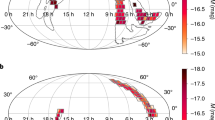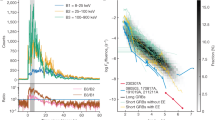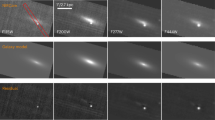Abstract
The merger of two neutron stars is predicted to give rise to three major detectable phenomena: a short burst of γ-rays, a gravitational-wave signal, and a transient optical–near-infrared source powered by the synthesis of large amounts of very heavy elements via rapid neutron capture (the r-process)1,2,3. Such transients, named ‘macronovae’ or ‘kilonovae’4,5,6,7, are believed to be centres of production of rare elements such as gold and platinum8. The most compelling evidence so far for a kilonova was a very faint near-infrared rebrightening in the afterglow of a short γ-ray burst9,10 at redshift z = 0.356, although findings indicating bluer events have been reported11. Here we report the spectral identification and describe the physical properties of a bright kilonova associated with the gravitational-wave source12 GW170817 and γ-ray burst13,14 GRB 170817A associated with a galaxy at a distance of 40 megaparsecs from Earth. Using a series of spectra from ground-based observatories covering the wavelength range from the ultraviolet to the near-infrared, we find that the kilonova is characterized by rapidly expanding ejecta with spectral features similar to those predicted by current models15,16. The ejecta is optically thick early on, with a velocity of about 0.2 times light speed, and reaches a radius of about 50 astronomical units in only 1.5 days. As the ejecta expands, broad absorption-like lines appear on the spectral continuum, indicating atomic species produced by nucleosynthesis that occurs in the post-merger fast-moving dynamical ejecta and in two slower (0.05 times light speed) wind regions. Comparison with spectral models suggests that the merger ejected 0.03 to 0.05 solar masses of material, including high-opacity lanthanides.
This is a preview of subscription content, access via your institution
Access options
Access to this article via Institution of Civil Engineers Library is not available.
Access Nature and 54 other Nature Portfolio journals
Get Nature+, our best-value online-access subscription
$29.99 / 30 days
cancel any time
Subscribe to this journal
Receive 51 print issues and online access
$199.00 per year
only $3.90 per issue
Buy this article
- Purchase on SpringerLink
- Instant access to full article PDF
Prices may be subject to local taxes which are calculated during checkout



Similar content being viewed by others
References
Lattimer, J. M., Mackie, F., Ravenhall, D. G. & Schramm, D. N. The decompression of cold neutron star matter. Astrophys. J. 213, 225–233 (1977)
Eichler, D., Livio, M., Piran, T. & Schramm, D. Nucleosynthesis, neutrino bursts and gamma-rays from coalescing neutron stars. Nature 340, 126–128 (1989)
Li, L.-X. & Paczyn´ski, B. Transient events from neutron star mergers. Astrophys. J. 507, L59–L62 (1998)
Kulkarni, S. R. Modelling supernova-like explosions associated with gamma-ray bursts with short durations. Preprint at https://arxiv.org/abs/astro-ph/0510256 (2005)
Tanaka, M. & Hotokezaka, K. Radiative transfer simulations of neutron star merger ejecta. Astrophys. J. 775, 113 (2013)
Rosswog, S. et al. Detectability of compact binary merger macronovae. Class. Quantum Gravity 34, 104001 (2017)
Wollaeger, R. T. et al. Impact of ejecta morphology and composition on the electromagnetic signatures of neutron star mergers. Preprint at https://arxiv.org/abs/1705.07084 (2017)
Metzger, B. D. Kilonovae. Living Rev. Relativ. 20, 3 (2017)
Tanvir, N. R. et al. A ‘kilonova’ associated with the short-duration γ-ray burst GRB 130603B. Nature 500, 547–549 (2013)
Berger, E., Fong, W. & Chornock, R. An r-process kilonova associated with the short-hard GRB 130603B. Astrophys. J. 774, L23 (2013)
Jin, Z.-P. et al. The macronova in GRB 050709 and the GRB-macronova connection. Nat. Commun. 7, 12898 (2016)
The LIGO Scientific Collaboration and the Virgo Collaboration. GW170817: observation of gravitational waves from a binary neutron star inspiral. Phys. Rev. Lett. 119, 161101 (2017)
Goldstein, A. et al. An ordinary short gamma-ray burst with extraordinary implications: Fermi-GBM detection of GRB 170817A. Astrophys. J. 848, https://doi.org/10.3847/2041-8213/aa8f41 (2017)
Savchenko, V. et al. INTEGRAL detection of the first prompt gamma-ray signal coincident with the gravitational event GW170817. Astrophys. J. 848, https://doi.org/10.3847/2041-8213/aa8f94 (2017)
Kasen, D., Fernández, R. & Metzger, B. D. Kilonova light curves from the disc wind outflows of compact object mergers. Mon. Not. R. Astron. Soc. 450, 1777–1786 (2015)
Tanaka, M. et al. Properties of kilonovae from dynamical and post-merger ejecta of neutron star mergers. Preprint at https://arxiv.org/abs/1708.09101 (2017)
Coulter, D. A. et al. Swope Supernova Survey 2017a (SSS17a), the optical counterpart to a gravitational wave source. Science http://doi.org/10.1126/science.aap9811 (2017)
Valenti, S. et al. The discovery of the electromagnetic counterpart of GW170817: kilonova AT 2017gfo/DLT17ck. Astrophys. J. 848, https://doi.org/10.3847/2041-8213/aa8edf (2017)
Jones, D. H. et al. The 6dF galaxy survey: final redshift release (DR3) and southern large-scale structures. Mon. Not. R. Astron. Soc. 399, 683–698 (2009)
Kasliwal, M. M. et al. Illuminating gravitational waves: a concordant picture of photons from a neutron star merger. Science http://doi.org/10.1126/science.aap9455 (2017)
Cardelli, J. A., Clayton, G. C. & Mathis, J. S. The relationship between infrared, optical, and ultraviolet extinction. Astrophys. J. 345, 245–256 (1989)
Malesani, D. et al. LIGO/Virgo G298048: optical spectral energy distribution of SSS17a. GCN Circ. 21577 (2017)
Troja, E. et al. The X-ray counterpart to the gravitational-wave event GW170817. Nature http://doi.org/10.1038/nature24290 (2017)
Patricelli, B. et al. Prospects for joint observations of gravitational waves and gamma rays from merging neutron star binaries. J. Cosmol. Astropart. Phys. 11, 56 (2016)
Salafia, O. S., Ghisellini, G., Pescalli, A., Ghirlanda, G. & Nappo, F. Structure of gamma-ray burst jets: intrinsic versus apparent properties. Mon. Not. R. Astron. Soc. 450, 3549–3558 (2015)
Lazzati, D. et al. Off-axis prompt X-ray transients from the cocoon of short gamma-ray bursts. Preprint at https://arxiv.org/abs/1709.01468 (2017)
Nakar, E. & Piran, T. The observable signatures of GRB cocoons. Astrophys. J. 834, 28 (2016)
Bannister, K. et al. LIGO/Virgo G298048: ATCA detection of a radio source coincident with NGC 4993. GCN Circ. 21559 (2017)
Evans, P. A. et al. Swift and NuSTAR observations of GW170817: detection of a blue kilonova. Science http://doi.org/10.1126/science.aap9580 (2017)
Fong, W. & Berger, E. Hubble Space Telescope observations of short gamma-ray burst host galaxies: morphologies, offsets, and local environments. Astrophys. J. 708, 9–25 (2010)
Belczynski, K. et al. A study of compact object mergers as short gamma-ray burst progenitors. Astrophys. J. 648, 1110–1116 (2006)
Levan, A. J. et al. The environment of the binary neutron star merger GW170817. Astrophys. J. 848, https://doi.org/10.3847/2041-8213/aa905f (2017)
Chincarini, G. et al. The last born at La Silla: REM, the Rapid Eye Mount. Messenger 113, 40–44 (2003)
Melandri, A. et al. LIGO/Virgo G298048: REM optical/NIR observations of candidate in NGC 4993. GCN Circ. 21532 (2017)
Melandri, A. et al. LIGO/Virgo G298048: REM optical/NIR observations. GCN Circ. 21556 (2017)
Pian, E. et al. LIGO/Virgo G298048: GRAWITA VLT/X-shooter observations and tentative redshift of SSS17a. GCN Circ. 21592 (2017)
D’Avanzo, P. et al. LIGO/Virgo G298048: ESO/VLT optical observations. GCN Circ. 21653 (2017)
Grado, A. et al. LIGO/VIRGO G298048: INAF VST-ESO PARANAL observations. GCN Circ. 21598 (2017)
Grado, A. et al. LIGO/VIRGO G298048: INAF VST-ESO PARANAL observations of NGC4993. GCN Circ. 21703 (2017)
Bertin, E. & Arnouts, S. SExtractor: software for source extraction. Astron. Astrophys. Suppl. Ser. 117, 393–404 (1996)
Capaccioli, M. & Schipani, P. The VLT survey telescope opens to the sky: history of a commissioning. Messenger 146, 2–7 (2011)
Kuijken, K. OmegaCAM: ESO’s newest imager. Messenger 146, 8–11 (2011)
Grado, A., Capaccioli, M., Limatola, L. & Getman, F. VST processing facility: first astronomical applications. Mem. Soc. Astron. It. Suppl. 19, 362 (2012)
Tody, D. IRAF in the Nineties. In Astronomical Data Analysis Software and Systems II (eds Hanisch, R. J. et al. .) 173–183 (ASP Conf. Ser. Vol. 52, 1993)
Vernet, J. et al. X-shooter, the new wide band intermediate resolution spectrograph at the ESO Very Large Telescope. Astron. Astrophys. 536, A105 (2011)
Freudling, W. et al. Automated data reduction workflows for astronomy. The ESO Reflex environment. Astron. Astrophys. 559, A96 (2013)
Modigliani, A. et al. The X-shooter pipeline. Proc. SPIE 7737, http://doi.org/10.1117/12.857211 (2010)
Moehler, S. et al. Flux calibration of medium-resolution spectra from 300 nm to 2500 nm: model reference spectra and telluric correction. Astron. Astrophys. 568, A9 (2014)
Noll, S. et al. An atmospheric radiation model for Cerro Paranal. I. The optical spectral range. Astron. Astrophys. 543, A92 (2012)
Jones, A. et al. An advanced scattered moonlight model for Cerro Paranal. Astron. Astrophys. 560, A91 (2013)
Smette, A. et al. Molecfit: a general tool for telluric absorption correction. I. Method and application to ESO instruments. Astron. Astrophys. 576, A77 (2015)
Kausch, W. et al. Molecfit: a general tool for telluric absorption correction. II. Quantitative evaluation on ESO-VLT/X-Shooter spectra. Astron. Astrophys. 576, A78 (2015)
Horne, W. An optimal extraction algorithm for CCD spectroscopy. Publ. Astron. Soc. Pac. 98, 609–617 (1986)
Fried, D. L. Limiting resolution looking down through the atmosphere. J. Opt. Soc. Am. 56, 1380–1384 (1966)
Poznanski, D., Prochaska, J. X. & Bloom, J. S. An empirical relation between sodium absorption and dust extinction. Mon. Not. R. Astron. Soc. 426, 1465–1474 (2012)
Munari, U. & Zwitter, T. Equivalent width of Na I and K I lines and reddening. Astron. Astrophys. 318, 269–274 (1997)
Munari, U. et al. Diffuse interstellar bands in RAVE survey spectra. Astron. Astrophys. 488, 969–973 (2008)
Schlafly, E. F. & Finkbeiner, D. P. Measuring reddening with Sloan Digital Sky Survey stellar spectra and recalibrating SFD. Astrophys. J. 737, 103 (2011)
Mazzali, P., Valenti, S. & Della Valle, M. The metamorphosis of supernova SN 2008D/XRF 080109: a link between supernovae and GRBs/hypernovae. Science 321, 1185–1188 (2008)
Harutyunyan, A. et al. ESC supernova spectroscopy of non-ESC targets. Astron. Astrophys. 488, 383–399 (2008)
Pan, Y.-C. The old host-galaxy environment of SSS17a, the first electromagnetic counterpart to a gravitational-wave source. Astrophys. J. 848, https://doi.org/10.3847/2041-8213/aa9116 (2017)
Levan, A. J. et al. LIGO/Virgo G298048: MUSE Integral field observations. GCN Circ. 21681 (2017)
Hallinan, G. et al. A radio counterpart to a neutron star merger. Science http://doi.org/10.1126/science.aap9855 (2017)
Alexander, K. D. et al. The electromagnetic counterpart of the binary neutron star merger LIGO/VIRGO GW170817. VI. Radio constraints on a relativistic jet and predictions for late-time emission from the kilonova ejecta. Astrophys. J. 848, https://doi.org/10.3847/2041-8213/aa905d (2017)
Goldstein, A. et al. LIGO/Virgo G298048: update on Fermi/GBM GRB 170817A analysis. GCN Circ. 21528 (2017)
D’Avanzo, P. et al. A complete sample of bright Swift short gamma-ray bursts. Mon. Not. R. Astron. Soc. 442, 2342–2356 (2014)
Berger, E. Short-duration gamma-ray bursts. Annu. Rev. Astron. Astrophys. 52, 43–105 (2014)
Ghisellini, G. et al. Are GRB980425 and GRB031203 real outliers or twins of GRB060218? Mon. Not. R. Astron. Soc. 372, 1699–1709 (2006)
Salafia, O. S., Ghisellini, G., Pescalli, A., Ghirlanda, G. & Nappo, F. Light curves and spectra from off-axis gamma-ray bursts. Mon. Not. R. Astron. Soc. 461, 3607–3619 (2016)
Wanderman, D. & Piran, T. The rate, luminosity function and time delay of non-collapsar short GRBs. Mon. Not. R. Astron. Soc. 448, 3026–3037 (2015)
Ghirlanda, G. et al. Short gamma-ray bursts at the dawn of the gravitational wave era. Astron. Astrophys. 594, A84 (2016)
Fong, W. et al. The afterglow and early-type host galaxy of the short GRB 150101B at z = 0.1343. Astrophys. J. 833, 151 (2016)
Ghirlanda, G. et al. Gamma-ray bursts in the comoving frame. Mon. Not. R. Astron. Soc. 420, 483–494 (2012)
Liang, E.-W. et al. A comprehensive study of gamma-ray burst optical emission. II. Afterglow onset and late re-brightening components. Astrophys. J. 774, 13 (2013)
Haggard, D. et al. A deep Chandra X-ray study of neutron star coalescence GW170817. Astrophys. J. 848, https://doi.org/10.3847/2041-8213/aa8ede (2017)
Moldon, J. & Beswick, R. LIGO/Virgo G298048: e-MERLIN upper limits on 5 GHz compact emission from SSS17a. GCN Circ. 21804 (2017)
Mooley, K. et al. LIGO/VIRGO G298048: MeerKAT observations of SSS17a. GCN Circ. 21891 (2017)
van Eerten, H. J., Leventis, K., Meliani, Z., Wijers, R. A. M. J. & Keppens, R. Gamma-ray burst afterglows from transrelativistic blast wave simulations. Mon. Not. R. Astron. Soc. 403, 300–316 (2010)
Acknowledgements
This work is based on observations made with the ESO telescopes at the Paranal Observatory under programmes ID 099.D-0382 (Principal Investigator (PI): E. Pian), 099.D-0622 (PI: P.D’A.), 099.D-0191 (PI: A. Grado) and with the REM telescope at the ESO La Silla Observatory under programme ID 35020 (PI: S. Campana). Gemini observatory data were obtained under programme GS-2017B-DD-1 (PI: L. P. Singer). We thank the Gemini Observatory for performing these observations, the ESO Director General for allocating discretionary time and the ESO operation staff for support. We thank D. Fugazza for technical support with operating the REM telescope remotely and REM telescope director E. Molinari. We acknowledge INAF for supporting the project ‘Gravitational Wave Astronomy with the first detections of adLIGO and adVirgo experiments—GRAWITA’ (PI: E.B.) and support from ASI grant I/004/11/3. J.H. was supported by a VILLUM FONDEN Investigator grant (project number 16599). M.M.K. acknowledges support from the GROWTH (Global Relay of Observatories Watching Transients Happen) project funded by the National Science Foundation under PIRE grant number 1545949.
Author information
Authors and Affiliations
Contributions
E. Pian and P.D’A. coordinated the work. J.S. reduced all the X-shooter spectra presented in Fig. 2 and wrote the relevant sections. M.T. developed the kilonova spectral models. E.C. assisted with the spectral analysis. P.A.M. linked the spectral observations with kilonova theory, coordinated their theoretical interpretation, matched the synthetic with observed spectra (Fig. 3), and wrote the corresponding parts of the paper. S. Campana coordinated the REM observations. S. Covino, A. Grado and A.M. reduced and analysed the optical photometry data (Fig. 1). M.M.K. provided the Gemini spectrum. D.M. assisted with early observation planning. G. Ghirlanda, G. Ghisellini and O.S.S. wrote the section on the off-beam jet (with contributions from L.A., M.G.B., Y.Z.F., Z.-P.J., B.P., T.P. and A.S.). D.W. assisted with the analysis of spectra using thermal models and with writing the paper. E.B. was the PI of the GRAvitational Wave Inaf TeAm (GRAWITA), which works on gravitational-wave electromagnetic follow-up programmes at ESO and other telescopes in Italy and the Canary Islands. M.B. liaised between the GRAWITA and LIGO-Virgo collaborations. A. Grado coordinated the ESO-VST observations. L.L. and F.G. developed the pipeline to reduce the VST data. N.R.T. and A.L. assisted with near-infrared data calibration issues. J.P.U.F., J.H. and C.K. helped write the paper and provided short-GRB expertise. L. Nicastro supervised the data flow and handling. S.P. and V.D. contributed to the data reduction and analysis of the X-shooter spectra. E. Palazzi, A.R., G.S. and G. Greco participated in the organization of the observations and image analysis and provided specific input for photometry calibration. L.T., S.Y. and S.B. contributed to the data analysis, with particular reference to interstellar medium spectral features. P.M. assisted with issues related to ESO policies and observation planning. All GRAWITA members contributed to several phases of the work, from the preparation of proposals, coordination with the LIGO–Virgo collaborations and activation of approved programmes at many facilities to data acquisition, reduction, analysis, interpretation and presentation.
Corresponding author
Ethics declarations
Competing interests
The authors declare no competing financial interests.
Additional information
Reviewer Information Nature thanks R. Chevalier, C. Miller and the other anonymous reviewer(s) for their contribution to the peer review of this work.
Publisher's note: Springer Nature remains neutral with regard to jurisdictional claims in published maps and institutional affiliations.
Extended data figures and tables
Extended Data Figure 1 Image of the NGC 4993 galaxy.
The image was obtained with the X-shooter acquisition camera (z filter). The X-shooter slit is overlaid as a rectangle. The position of the optical transient is marked by a blue circle. The position of the line emission in the slit is marked by an ellipse. The dust lanes that are visible in the host intersect the slit at the position of the line emission.
Extended Data Figure 2 Blackbody fit to the AT 2017gfo spectra.
The two early X-shooter spectra of GW170817, obtained 1.5 and 3.5 days after discovery, are compared with the spectra of the type-Ib supernova SN 2008D59, obtained 2–5 days after the explosion (light grey, arbitrarily scaled in flux, ×10−16). The shaded areas represent wavelength intervals with low atmospheric transmission. The dotted green lines show the black-body fits of the optical continuum of GW170817 with temperature 5,000 K and 3,200 K.
Extended Data Figure 3 Two-dimensional image of the AT 2017gfo spectrum.
Top, the rectified, X-shooter two-dimensional image. The dark line visible across the entire spectral window is the bright continuum of the optical transient and the offset. The dark green blobs indicate the position of the line emission from N ii λ ≈ 6,549 Å, Hα and N ii λ ≈ 6,583 Å. Bottom, the line emission and the line fits. The integrated line fluxes are given, normalized by a factor of 10−17 for clarity. The error bars on the black points represent the individual 1σ spectral uncertainties. The blue shaded area represents 1σ uncertainty.
Extended Data Figure 4 Off-axis GRB afterglow model.
Synthetic X-ray (black curve), optical (dark grey curve) and radio (light grey curve) light curves of the GRB afterglow, as predicted by an off-axis jet model, derived using standard afterglow dynamics and radiation codes78. The filled circle shows the X-ray detection23 and the squares with arrows show two representative radio upper limits76,77.
Rights and permissions
About this article
Cite this article
Pian, E., D’Avanzo, P., Benetti, S. et al. Spectroscopic identification of r-process nucleosynthesis in a double neutron-star merger. Nature 551, 67–70 (2017). https://doi.org/10.1038/nature24298
Received:
Accepted:
Published:
Issue Date:
DOI: https://doi.org/10.1038/nature24298



